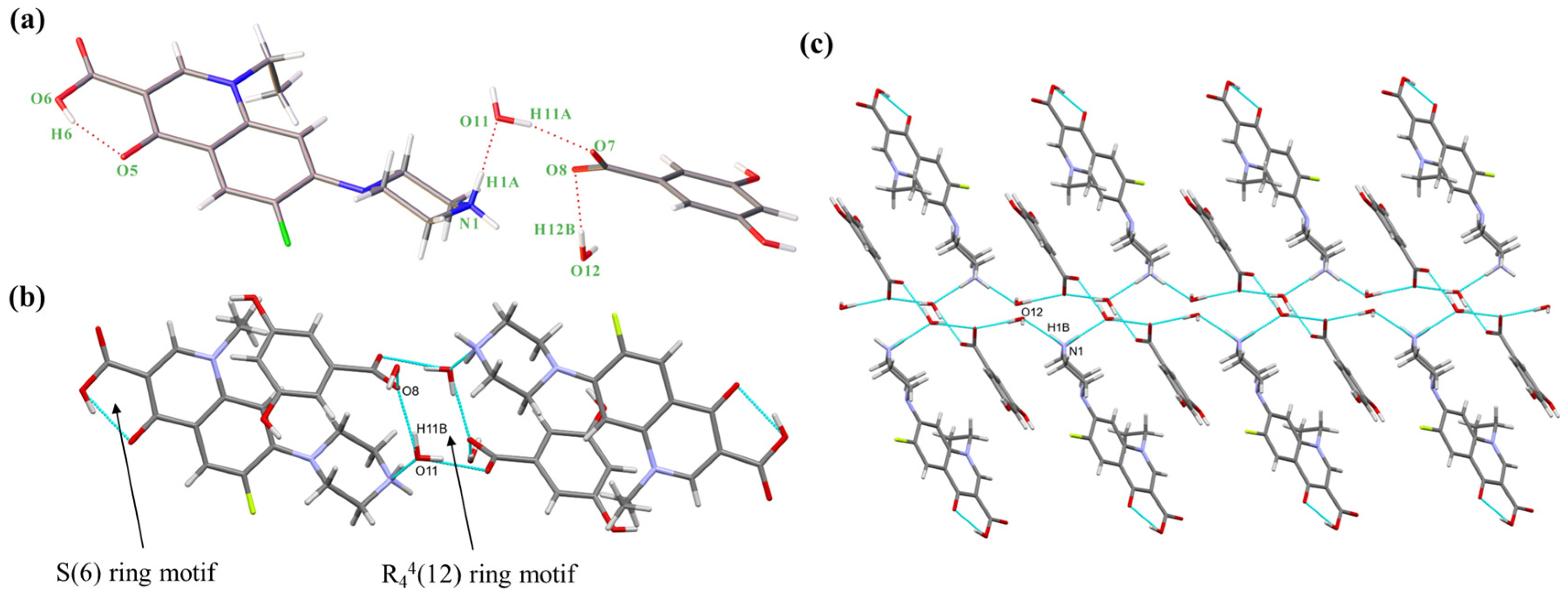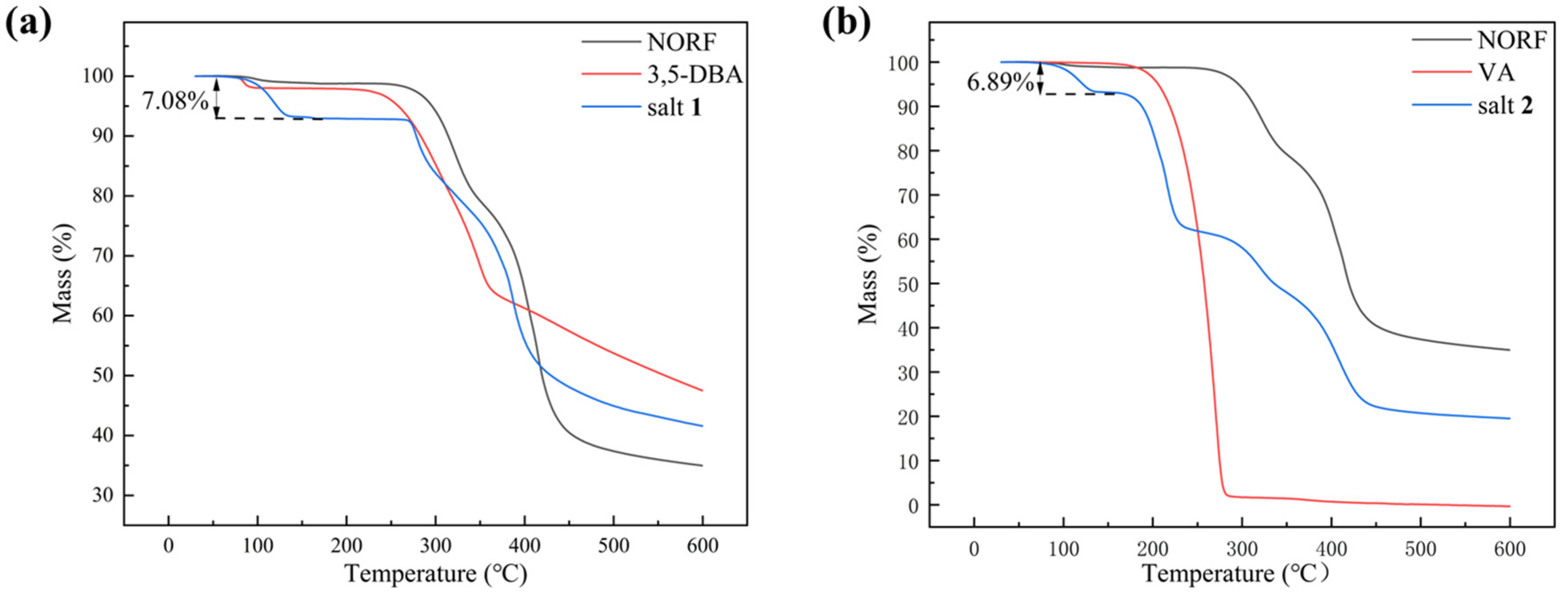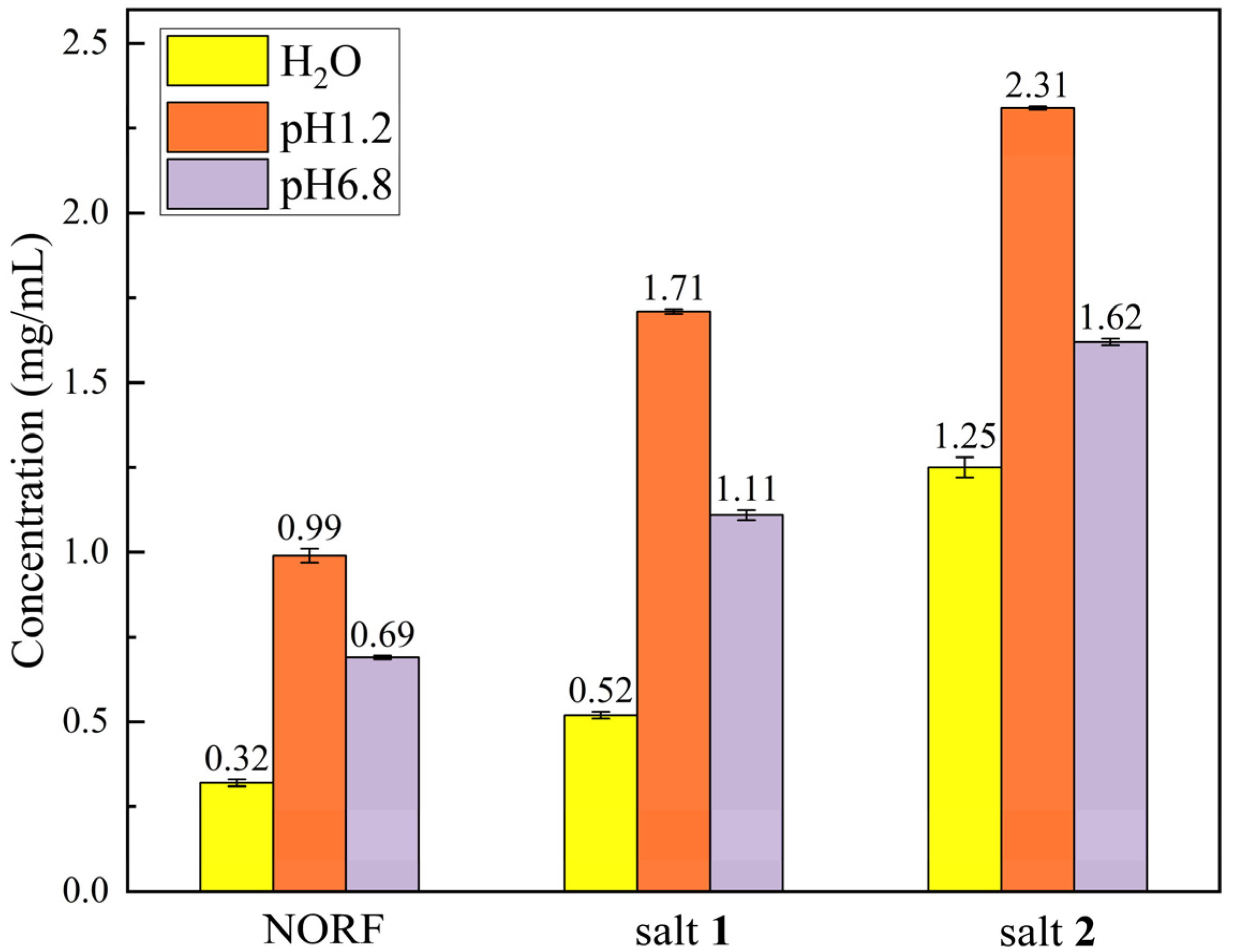Two Novel Hydrate Salts of Norfloxacin with Phenolic Acids and Their Physicochemical Properties
Abstract
:1. Introduction
2. Results and Discussion
2.1. SCXRD Analysis
2.1.1. NORF—3,5-DBA Hydrate (Salt 1)
2.1.2. NORF—VA Hydrate (Salt 2)
2.2. PXRD Analysis
2.3. Thermal Analysis
2.4. FT-IR Analysis
2.5. Equilibrium Solubility Study
2.6. In Vitro Powder Dissolution Study
2.7. Antibacterial Activity Study
3. Materials and Methods
3.1. Materials
3.2. Synthesis of Salts
3.2.1. NORF—3,5-DBA Hydrate (1:1:2) Salt 1
3.2.2. NORF—VA Hydrate (1:1:2) Salt 2
3.3. Single-Crystal X-ray Diffraction (SCXRD)
3.4. Powder X-ray Diffraction (PXRD)
3.5. Differential Scanning Calorimetry (DSC)
3.6. Thermogravimetric Analysis (TGA)
3.7. Fourier-Transform Infrared Spectrophotometry (FT-IR)
3.8. High-Performance Liquid Chromatography (HPLC)
3.9. Equilibrium Solubility Measurement
3.10. In Vitro Powder Dissolution
3.11. Antibacterial Activity Measurement
4. Summary
Supplementary Materials
Author Contributions
Funding
Institutional Review Board Statement
Informed Consent Statement
Data Availability Statement
Conflicts of Interest
References
- Hirshberg, B.; Gerber, R.B.; Krylov, A.I. Calculations Predict a Stable Molecular Crystal of N8. Nat. Chem. 2014, 6, 52–56. [Google Scholar] [CrossRef] [PubMed]
- Dahan, A.; Beig, A.; Lindley, D.; Miller, J.M. The Solubility–Permeability Interplay and Oral Drug Formulation Design: Two Heads Are Better than One. Adv. Drug Deliv. Rev. 2016, 101, 99–107. [Google Scholar] [CrossRef] [PubMed]
- Vaz, G.R.; Carrasco, M.C.F.; Batista, M.M.; Barros, P.A.B.; Oliveira, M.d.C.; Muccillo-Baisch, A.L.; Yurgel, V.C.; Buttini, F.; Soares, F.A.A.; Cordeiro, L.M.; et al. Curcumin and Quercetin-Loaded Lipid Nanocarriers: Development of Omega-3 Mucoadhesive Nanoemulsions for Intranasal Administration. Nanomaterials 2022, 12, 1073. [Google Scholar] [CrossRef]
- Markovic, M.; Zur, M.; Garsiani, S.; Porat, D.; Cvijić, S.; Amidon, G.L.; Dahan, A. The Role of Paracellular Transport in the Intestinal Absorption and Biopharmaceutical Characterization of Minoxidil. Pharmaceutics 2022, 14, 1360. [Google Scholar] [CrossRef]
- Petersen, E.F.; Larsen, B.S.; Nielsen, R.B.; Pijpers, I.; Versweyveld, D.; Holm, R.; Tho, I.; Snoeys, J.; Nielsen, C.U. Co-Release of Paclitaxel and Encequidar from Amorphous Solid Dispersions Increase Oral Paclitaxel Bioavailability in Rats. Int. J. Pharm. 2024, 654, 123965. [Google Scholar] [CrossRef] [PubMed]
- Madgulkar, A.; Bhalekar, M.R.; Dikpati, A.A. Improving Oral Bioavailability of Acyclovir Using Nanoparticulates of Thiolated Xyloglucan. Int. J. Biol. Macromol. 2016, 89, 689–699. [Google Scholar] [CrossRef]
- Jiang, X.; Zhao, Y.; Guan, Q.; Xiao, S.; Dong, W.; Lian, S.; Zhang, H.; Liu, M.; Wang, Z.; Han, J. Amorphous Solid Dispersions of Cyclosporine A with Improved Bioavailability Prepared via Hot Melt Extrusion: Formulation, Physicochemical Characterization, and in Vivo Evaluation. Eur. J. Pharm. Sci. 2022, 168, 106036. [Google Scholar] [CrossRef]
- Lesher, G.Y.; Froelich, E.J.; Gruett, M.D.; Bailey, J.H.; Brundage, R.P. 1,8-Naphthyridine Derivatives. A New Class of Chemotherapeutic Agents. J. Med. Chem. 1962, 5, 1063–1065. [Google Scholar] [CrossRef]
- Koyle, M.A.; Barqawi, A.; Wild, J.; Passamaneck, M.; Furness, P.D., III. Pediatric Urinary Tract Infections: The Role of Fluoroquinolones. Pediatr. Infect. Dis. J. 2003, 22, 1133–1137. [Google Scholar] [CrossRef]
- Shen, L.; Chu, D. Type II DNA Topoisomerases as Antibacterial Targets. Curr. Pharm. Des. 1996, 2, 195–208. [Google Scholar] [CrossRef]
- Marians, K.J.; Hiasa, H. Mechanism of Quinolone Action: A Drug-Induced Structural Perturbation of the DNA Precedes Strand Cleavage by Topoisomerase IV. J. Biol. Chem. 1997, 272, 9401–9409. [Google Scholar] [CrossRef] [PubMed]
- Breda, S.A.; Jimenez-Kairuz, A.F.; Manzo, R.H.; Olivera, M.E. Solubility Behavior and Biopharmaceutical Classification of Novel High-Solubility Ciprofloxacin and Norfloxacin Pharmaceutical Derivatives. Int. J. Pharm. 2009, 371, 106–113. [Google Scholar] [CrossRef] [PubMed]
- Fael, H.; Barbas, R.; Prohens, R.; Ràfols, C.; Fuguet, E. Synthesis and Characterization of a New Norfloxacin/Resorcinol Cocrystal with Enhanced Solubility and Dissolution Profile. Pharmaceutics 2021, 14, 49. [Google Scholar] [CrossRef] [PubMed]
- Takács-Novák, K.; Noszál, B.; Hermecz, I.; Keresztúri, G.; Podányi, B.; Szasz, G. Protonation Equilibria of Quinolone Antibacterials. J. Pharm. Sci. 1990, 79, 1023–1028. [Google Scholar] [CrossRef] [PubMed]
- Almeida, H.F.; Freire, M.G.; Marrucho, I.M. Improved Monitoring of Aqueous Samples by the Preconcentration of Active Pharmaceutical Ingredients Using Ionic-Liquid-Based Systems. Green Chem. 2017, 19, 4651–4659. [Google Scholar] [CrossRef]
- Ross, D.L.; Riley, C.M. Aqueous Solubilities of Some Variously Substituted Quinolone Antimicrobials. Int. J. Pharm. 1990, 63, 237–250. [Google Scholar] [CrossRef]
- De Souza, M.V. New Fluoroquinolones: A Class of Potent Antibiotics. Mini Rev. Med. Chem. 2005, 5, 1009–1017. [Google Scholar] [CrossRef]
- Mendes, C.; Meirelles, G.C.; Barp, C.G.; Assreuy, J.; Silva, M.A.; Ponchel, G. Cyclodextrin Based Nanosponge of Norfloxacin: Intestinal Permeation Enhancement and Improved Antibacterial Activity. Carbohydr. Polym. 2018, 195, 586–592. [Google Scholar] [CrossRef]
- Dave, V.; Yadav, R.B.; Kushwaha, K.; Yadav, S.; Sharma, S.; Agrawal, U. Lipid-Polymer Hybrid Nanoparticles: Development & Statistical Optimization of Norfloxacin for Topical Drug Delivery System. Bioact. Mater. 2017, 2, 269–280. [Google Scholar]
- Tomar, S.; Chakraborti, S.; Jindal, A.; Grewal, M.K.; Chadha, R. Cocrystals of Diacerein: Towards the Development of Improved Biopharmaceutical Parameters. Int. J. Pharm. 2020, 574, 118942. [Google Scholar] [CrossRef]
- Wang, H.; Yang, D.; Zhang, W.; Song, J.; Gong, N.; Yu, M.; Yang, S.; Zhang, B.; Liu, Q.; Du, G.; et al. An Innovative Rhein-Matrine Cocrystal: Synthesis, Characterization, Formation Mechanism and Pharmacokinetic Study. Chin. Chem. Lett. 2023, 34, 107258. [Google Scholar] [CrossRef]
- Vaksler, Y.A.; Benedis, D.; Dyshin, A.A.; Oparin, R.D.; Correia, N.T.; Capet, F.; Shishkina, S.V.; Kiselev, M.G.; Idrissi, A. Spectroscopic Characterization of Single Co-Crystal of Mefenamic Acid and Nicotinamide Using Supercritical CO2. J. Mol. Liq. 2021, 334, 116117. [Google Scholar] [CrossRef]
- Shaikh, R.; Singh, R.; Walker, G.M.; Croker, D.M. Pharmaceutical Cocrystal Drug Products: An Outlook on Product Development. Trends Pharmacol. Sci. 2018, 39, 1033–1048. [Google Scholar] [CrossRef] [PubMed]
- Ren, S.; Liu, M.; Hong, C.; Li, G.; Sun, J.; Wang, J.; Zhang, L.; Xie, Y. The Effects of pH, Surfactant, Ion Concentration, Coformer, and Molecular Arrangement on the Solubility Behavior of Myricetin Cocrystals. Acta Pharm. Sin. B 2019, 9, 59–73. [Google Scholar] [CrossRef] [PubMed]
- Bolla, G.; Sarma, B.; Nangia, A.K. Crystal Engineering of Pharmaceutical Cocrystals in the Discovery and Development of Improved Drugs. Chem. Rev. 2022, 122, 11514–11603. [Google Scholar] [CrossRef]
- Pan, X.; Zheng, Y.; Chen, R.; Qiu, S.; Chen, Z.; Rao, W.; Chen, S.; You, Y.; Lü, J.; Xu, L.; et al. Cocrystal of Sulfamethazine and P-Aminobenzoic Acid: Structural Establishment and Enhanced Antibacterial Properties. Cryst. Growth Des. 2019, 19, 2455–2460. [Google Scholar] [CrossRef]
- Shemchuk, O.; d’Agostino, S.; Fiore, C.; Sambri, V.; Zannoli, S.; Grepioni, F.; Braga, D. Natural Antimicrobials Meet a Synthetic Antibiotic: Carvacrol/Thymol and Ciprofloxacin Cocrystals as a Promising Solid-State Route to Activity Enhancement. Cryst. Growth Des. 2020, 20, 6796–6803. [Google Scholar] [CrossRef]
- Duan, C.; Chen, Y.; Zhang, Y.; Liang, F.; Liu, W.; Xiao, X.; Xu, C.; Zhuang, T.; Hao, C.; Chen, Y. Two Cocrystals of Olaparib with Flavonoids toward Sustained Release: Structure, Dissolution Behavior, and Anticancer Activity Analysis. Cryst. Growth Des. 2022, 22, 4885–4894. [Google Scholar] [CrossRef]
- Pinto Vitorino, G.; Sperandeo, N.R.; Caira, M.R.; Mazzieri, M.R. A Supramolecular Assembly Formed by Heteroassociation of Ciprofloxacin and Norfloxacin in the Solid State: Co-Crystal Synthesis and Characterization. Cryst. Growth Des. 2013, 13, 1050–1058. [Google Scholar] [CrossRef]
- Velaga, S.P.; Basavoju, S.; Boström, D. Norfloxacin Saccharinate–Saccharin Dihydrate Cocrystal–A New Pharmaceutical Cocrystal with an Organic Counter Ion. J. Mol. Struct. 2008, 889, 150–153. [Google Scholar] [CrossRef]
- Ferreira, L.T.; Alarcon, R.T.; Perpétuo, G.L.; Bannach, G. Investigation and Characterization by TG/DTG–DTA and DSC of the Fusion of Riboflavin, and Its Interaction with the Antibiotic Norfloxacin in the Screening of Cocrystal. J. Therm. Anal. Calorim. 2019, 136, 581–588. [Google Scholar] [CrossRef]
- Yu, H.; Zhang, B.; Liu, M.; Xing, W.; Hu, K.; Yang, S.; He, G.; Gong, N.; Du, G.; Lu, Y. Design, Preparation, Characterization and Evaluation of Five Cocrystal Hydrates of Fluconazole with Hydroxybenzoic Acids. Pharmaceutics 2022, 14, 2486. [Google Scholar] [CrossRef]
- Sharma, R.; Singh, M.; Srijana, P.J.; Kamal; Narayana, B.; Sarojini, B.K.; Likhitha, U.; Murugavel, S.; Raj, J.M.; Kant, R. Synthesis, Characterization, Quantum Chemical Calculation, Hirshfeld Surface Analysis and Antibacterial Activity of a Co-Crystal of 4-Aminopyridine: P-Hydroxybenzoic Acid with a Water Molecule. J. Mol. Struct. 2023, 1284, 135309. [Google Scholar] [CrossRef]
- Yuan, Z.-J.; Dai, X.-L.; Huang, Y.-L.; Lu, T.-B.; Chen, J.-M. Cocrystals of Penciclovir with Hydroxybenzoic Acids: Synthesis, Crystal Structures, and Physicochemical Evaluation. Cryst. Growth Des. 2020, 20, 4108–4119. [Google Scholar] [CrossRef]
- Zou, Y.; Meng, X.; Zhang, B.; Yu, H.; He, G.; Gong, N.; Lu, Y.; Du, G. Gefitinib Salts/Cocrystals with Phenolic Acids as a Promising Solid-State Approach to Improve Solubility. CrystEngComm 2024, 26, 2112–2122. [Google Scholar] [CrossRef]
- Venkidasamy, B.; Subramanian, U.; Almoallim, H.S.; Alharbi, S.A.; Lakshmikumar, R.R.C.; Thiruvengadam, M. Vanillic Acid Nanocomposite: Synthesis, Characterization Analysis, Antimicrobial, and Anticancer Potentials. Molecules 2024, 29, 3098. [Google Scholar] [CrossRef]
- Bu, F.-Z.; Yu, Y.-M.; Shen, Y.-L.; Liu, L.; Yan, C.-W.; Wu, Z.-Y.; Li, Y.-T. Cocrystallization-Driven Self-Assembly with Vanillic Acid Offers a New Opportunity for Surmounting Fast and Excessive Absorption Issues of Antifungal Drug 5-Fluorocytosine: A Combined Theoretical and Experimental Research. CrystEngComm 2022, 24, 2777–2790. [Google Scholar] [CrossRef]
- da Silva, C.C.; Guimarães, F.F.; Ribeiro, L.; Martins, F.T. Salt or Cocrystal of Salt? Probing the Nature of Multicomponent Crystal Forms with Infrared Spectroscopy. Spectrochim. Acta Part A 2016, 167, 89–95. [Google Scholar] [CrossRef]
- Childs, S.L.; Stahly, G.P.; Park, A. The Salt−Cocrystal Continuum: The Influence of Crystal Structure on Ionization State. Mol. Pharm. 2007, 4, 323–338. [Google Scholar] [CrossRef]
- Garai, A.; Biradha, K. Cocrystals and Salts of 4,4′-Dinitro-2,2′,6,6′-Tetracarboxybiphenyl with N-Heterocycles: Solid State Photodimerization of Criss-Cross Aligned Olefins and Photophysical Properties. Cryst. Growth Des. 2020, 20, 8059–8070. [Google Scholar] [CrossRef]
- André, V.; Fernandes, A.; Santos, P.P.; Duarte, M.T. On the Track of New Multicomponent Gabapentin Crystal Forms: Synthon Competition and pH Stability. Cryst. Growth Des. 2011, 11, 2325–2334. [Google Scholar] [CrossRef]
- Gunnam, A.; Nangia, A.K. Novel Hydrate and Anhydrate Cocrystals/Salts of Norfloxacin and Their Physicochemical Properties. Cryst. Growth Des. 2023, 23, 4198–4213. [Google Scholar] [CrossRef]
- Cui, W.; He, Z.; Zhang, Y.; Fan, Q.; Feng, N. Naringenin Cocrystals Prepared by Solution Crystallization Method for Improving Bioavailability and Anti-Hyperlipidemia Effects. AAPS PharmSciTech 2019, 20, 1–12. [Google Scholar] [CrossRef]
- Prashar, M.; Mehta, V.; Singh, P.; Mangal, S.; Arora, P.; Harjai, K.; Chadha, R.; Dhingra, N. Structural and Biopharmaceutical Evaluation of Newly Synthesized Norfloxacin Co-Crystals Using Crystal Engineering Approach. J. Mol. Struct. 2023, 1292, 136175. [Google Scholar] [CrossRef]
- Singh, P.; Chadha, R. A New Polymorph of Ciprofloxacin Saccharinate: Structural Characterization and Pharmaceutical Profile. J. Pharm. Biomed. Anal. 2017, 146, 7–14. [Google Scholar] [CrossRef]
- Avdeef, A.; Fuguet, E.; Llinàs, A.; Ràfols, C.; Bosch, E.; Völgyi, G.; Verbić, T.; Boldyreva, E.; Takács-Novák, K. Equilibrium Solubility Measurement of Ionizable Drugs–Consensus Recommendations for Improving Data Quality. Admet Dmpk 2016, 4, 117–178. [Google Scholar] [CrossRef]
- Huang, Z.; Staufenbiel, S.; Bodmeier, R. Combination of Co-Crystal and Nanocrystal Techniques to Improve the Solubility and Dissolution Rate of Poorly Soluble Drugs. Pharm. Res. 2022, 39, 949–961. [Google Scholar] [CrossRef]
- Fiore, C.; Baraghini, A.; Shemchuk, O.; Sambri, V.; Morotti, M.; Grepioni, F.; Braga, D. Inhibition of the Antibiotic Activity of Cephalosporines by Co-Crystallization with Thymol. Cryst. Growth Des. 2022, 22, 1467–1475. [Google Scholar] [CrossRef]
- Serrano, D.R.; Persoons, T.; D’Arcy, D.M.; Galiana, C.; Dea-Ayuela, M.A.; Healy, A.M. Modelling and Shadowgraph Imaging of Cocrystal Dissolution and Assessment of in Vitro Antimicrobial Activity for Sulfadimidine/4-Aminosalicylic Acid Cocrystals. Eur. J. Pharm. Sci. 2016, 89, 125–136. [Google Scholar] [CrossRef]
- Bourhis, L.J.; Dolomanov, O.V.; Gildea, R.J.; Howard, J.A.; Puschmann, H. The Anatomy of a Comprehensive Constrained, Restrained Refinement Program for the Modern Computing Environment–Olex2 Dissected. Acta Crystallogr. A Found. Adv. 2015, 71, 59–75. [Google Scholar] [CrossRef]
- Sheldrick, G.M. Crystal Structure Refinement with SHELXL. Acta Crystallogr. C Struct. Chem. 2015, 71, 3–8. [Google Scholar] [CrossRef] [PubMed]
- Pennington, W.T. DIAMOND–Visual Crystal Structure Information System. J. Appl. Crystallogr. 1999, 32, 1028–1029. [Google Scholar] [CrossRef]
- Macrae, C.F.; Bruno, I.J.; Chisholm, J.A.; Edgington, P.R.; McCabe, P.; Pidcock, E.; Rodriguez-Monge, L.; Taylor, R.; Streek, J.; Wood, P.A. Mercury CSD 2.0–New Features for the Visualization and Investigation of Crystal Structures. J. Appl. Crystallogr. 2008, 41, 466–470. [Google Scholar] [CrossRef]
- Glomme, A.; März, J.; Dressman, J.B. Comparison of a Miniaturized Shake-Flask Solubility Method with Automated Potentiometric Acid/Base Titrations and Calculated Solubilities. J. Pharm. Sci. 2005, 94, 1–16. [Google Scholar] [CrossRef]








| MIC (μg/mL) | E. coli | P.aeruginosa | B.subtilis | S. aureus |
|---|---|---|---|---|
| NORF | 0.5 | 0.5 | 0.5 | 0.5 |
| 3,5-DBA | 512 | 512 | 512 | 512 |
| VA | 1024 | 1024 | 1024 | 1024 |
| salt 1 | 0.5 | 0.25 | 0.25 | 0.125 |
| salt 2 | 0.25 | 0.25 | 2 | 0.12 |
Disclaimer/Publisher’s Note: The statements, opinions and data contained in all publications are solely those of the individual author(s) and contributor(s) and not of MDPI and/or the editor(s). MDPI and/or the editor(s) disclaim responsibility for any injury to people or property resulting from any ideas, methods, instructions or products referred to in the content. |
© 2024 by the authors. Licensee MDPI, Basel, Switzerland. This article is an open access article distributed under the terms and conditions of the Creative Commons Attribution (CC BY) license (https://creativecommons.org/licenses/by/4.0/).
Share and Cite
Liang, D.; Li, F.; Duan, J.; Sun, W.; Yu, X. Two Novel Hydrate Salts of Norfloxacin with Phenolic Acids and Their Physicochemical Properties. Antibiotics 2024, 13, 888. https://doi.org/10.3390/antibiotics13090888
Liang D, Li F, Duan J, Sun W, Yu X. Two Novel Hydrate Salts of Norfloxacin with Phenolic Acids and Their Physicochemical Properties. Antibiotics. 2024; 13(9):888. https://doi.org/10.3390/antibiotics13090888
Chicago/Turabian StyleLiang, Di, Fei Li, Jingzhong Duan, Wei Sun, and Xiaoyan Yu. 2024. "Two Novel Hydrate Salts of Norfloxacin with Phenolic Acids and Their Physicochemical Properties" Antibiotics 13, no. 9: 888. https://doi.org/10.3390/antibiotics13090888
APA StyleLiang, D., Li, F., Duan, J., Sun, W., & Yu, X. (2024). Two Novel Hydrate Salts of Norfloxacin with Phenolic Acids and Their Physicochemical Properties. Antibiotics, 13(9), 888. https://doi.org/10.3390/antibiotics13090888







